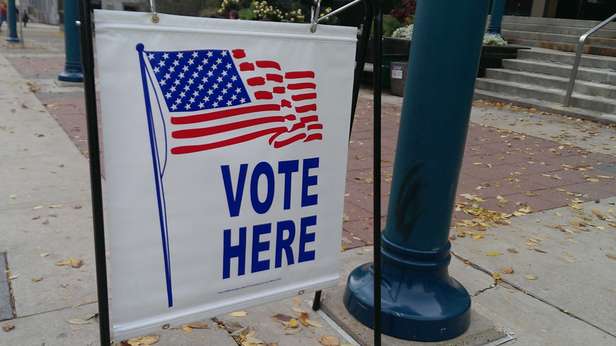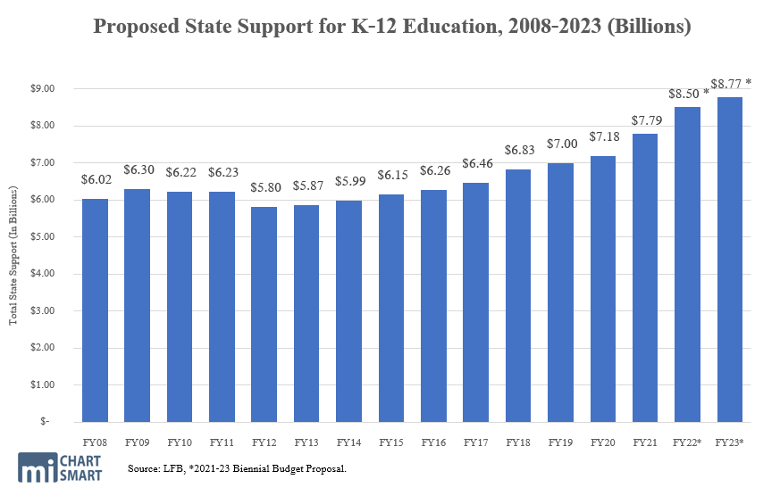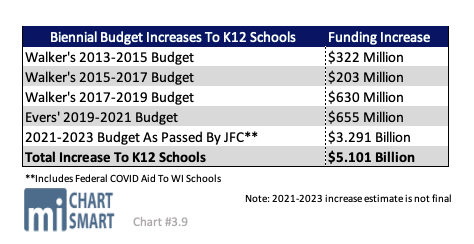
Even with massive state education spending increases and $2.5 billion in federal pandemic aid, still not enough for 81 districts
Apr. 4, 2022 | MacIver News Service
Hotly contested school board elections and other local and judicial races on ballots tomorrow are joined by school referenda questions asking voters to raise taxes to fund over $1.1 billion in new spending across 81 districts.
The context of these spending questions is unique this year. Some $2.5 billion – with a “B” – federal funding related to the pandemic has been flowing into school coffers over the past 2 years. That’s on top of the $686 million funding increase in the last state budget.
With schools receiving huge influxes of cash – some districts received over $10,000 additional cash per student, and Milwaukee Public Schools gets nearly $800 million additional federal pandemic funding – it’s no wonder taxpayers are asking why schools are asking for such huge sums. The Wheeler Report has compiled a list of the referenda up for a vote tomorrow, April 5th. Highlights include:
- West Allis is asking for the largest dollar amount: $149 million. Their pandemic funds were $24.2 million.
- Wausau has a $120 million ask on the ballot. This would be on top of their $16.5 million federal pandemic windfall.
- Chilton has about 1,100 students, and they received nearly $1.4 million in federal pandemic funds. They’re asking voters to increase taxes to fund a whopping $24 million in increased spending, some of it for an athletic complex. That’s $21,590 per student in spending increases.
- Amery, with under 1,500 students received $2.2 million in extra federal funds but is asking voters for over $43 million in spending.
- Tiny Argyle with under 300 students, which received more than $2,100 extra per student in pandemic funds is seeking OK for almost $2 million more spending.
- Hayward with 2,000 students is seeking nearly $50 million in their referendum – nearly $25,000 per student. Their federal pandemic aids alone were more than $4,000 per child.
To put the $1.1 billion referenda increases in perspective, if the costs were spread across the entire population of the state, it would cost every man, woman and child over $200 apiece. But these districts are raising the funds from district residents.

Every year, the education establishment cries poverty, asking for massive spending increases. And while school spending increases every year, they claim they have been cut if they don’t receive their full wish list.
This budget cycle, the Evers wish list was for an additional $1.6 billion to K12. The legislature OK’d a $686 million increase – and Evers himself took a victory lap on the funding increases in the budget. On top of that, $2.5 billion federal dollars poured in. That means schools are getting about $1.5 billion more than even the Evers pie-in-the-sky request. You’d be forgiven for imagining they might be satisfied.

But these $1.1 billion in referenda asks suggest school funding increases – no matter how high, no matter how sustained, no matter who kicks in the money – will never be enough.
While in recent years the number of referenda has remained comparatively stable, with a notable decrease in the years after Act 10 when schools were under closer scrutiny from voters on whether they were using their savings, a higher percentage are passing. (The Wheeler Report produced a chart showing recent history of school referenda, below.)
Why are so many spending hikes getting voter approval even in the face of sustained funding increases? One reason is that the education establishment has become more sophisticated, spending substantial tax dollars advertising the referenda to voters, convincing voters of their dire financial straits.
But funds don’t seem to be nearly as tight as some schools portray – Mount Horeb schools have repeatedly passed referenda for additional spending, but school board members recently touted their spending on gay pride flags to put “everywhere.” Small expenditures, on things that most voters don’t even know about, add up and point to a lack of fiscal stewardship from the same officials crying poverty.
On a much larger scale, Beloit schools, with precipitously declining enrollment, claim they are facing a shortfall of over $10 billion even though their share of federal pandemic funding is over $30 million, and they are receiving more state funding to educate fewer kids. And in 2012 they passed a $70 million dollar referendum. They don’t even have 6,000 children in their schools. It’s hard to imagine what, beyond fiscal mismanagement, could cause such a budget shortfall.
Recent Wisconsin School District Referenda History
| Calendar Year | Administration | # Total Referenda |
Issue Debt | Non-Recurring | Recurring | Passed | Failed | Percentage Passed |
| 2021 | Evers | 71 | 36 | 27 | 8 | 43 | 28 | 60.1 |
| 2020 | Evers | 111 | 49 | 42 | 20 | 95 | 16 | 85.6 |
| 2019 | Evers | 60 | 26 | 7 | 27 | 45 | 15 | 75 |
| 2018 | Walker | 156 | 84 | 51 | 21 | 140 | 16 | 89.7 |
| 2017 | Walker | 83 | 40 | 29 | 14 | 52 | 31 | 62.7 |
| 2016 | Walker | 154 | 83 | 47 | 24 | 122 | 32 | 79.2 |
| 2015 | Walker | 90 | 46 | 40 | 4 | 62 | 28 | 68.9 |
| 2014 | Walker | 119 | 51 | 53 | 15 | 80 | 38 | 67.2 |
| 2013 | Walker | 69 | 36 | 29 | 4 | 42 | 27 | 60.9 |
| 2012 | Walker | 79 | 43 | 29 | 7 | 53 | 24 | 67.1 |
| 2011 | Walker | 70 | 33 | 32 | 5 | 39 | 31 | 55.7 |
| 2010 | Doyle | 92 | 44 | 37 | 10 | 48 | 43 | 52.2 |
| 2009 | Doyle | 75 | 27 | 35 | 13 | 34 | 41 | 45.3 |
| 2008 | Doyle | 139 | 59 | 52 | 28 | 70 | 67 | 50.4 |
| 2007 | Doyle | 117 | 56 | 38 | 22 | 60 | 56 | 51.3 |
| 2006 | Doyle | 136 | 66 | 53 | 21 | 82 | 54 | 60.3 |
| 2005 | Doyle | 96 | 41 | 31 | 23 | 42 | 52 | 43.8 |
| 2004 | Doyle | 97 | 49 | 25 | 26 | 58 | 39 | 59.8 |
| 2003 | Doyle | 106 | 57 | 21 | 28 | 26 | 80 | 24.5 |
| 2002 | McCallum | 104 | 59 | 24 | 21 | 37 | 66 | 35.5 |
| 2001 | McCallum | 167 | 83 | 29 | 53 | 71 | 94 | 42.5 |
| 2000 | Thompson | 192 | 110 | 33 | 49 | 108 | 84 | 56.2 |
| 1999 | Thompson | 167 | 103 | 28 | 36 | 78 | 89 | 46.4 |
Chart courtesy of The Wheeler Report
With an increase in state spending coupled with $2.5 billion new federal dollars pouring in, it would seem like Wisconsin schools’ wildest dreams have been realized. But it’s not enough the education establishment, and they’re asking for another $1.1 billion.
Tomorrow’s results will tell a tale. Are voters willing to open their wallets, believing their schools truly lack funds?
What the results won’t show is whether those voters understand how many of their tax dollars have already been poured into schools and whether their elected officials are managing those funds responsibly.